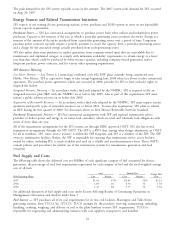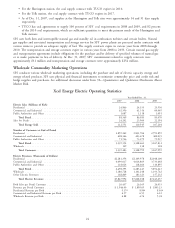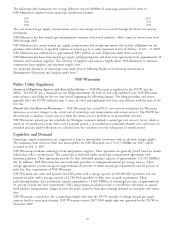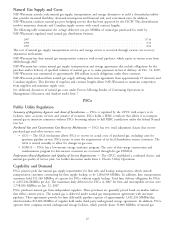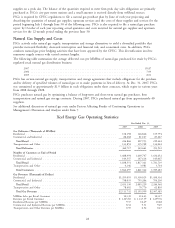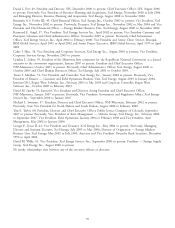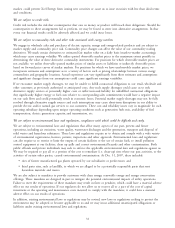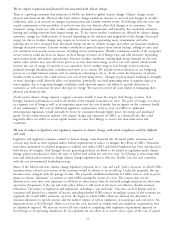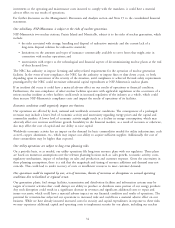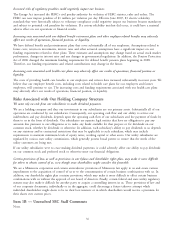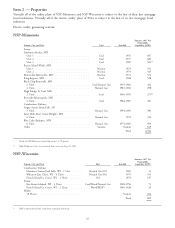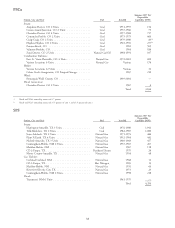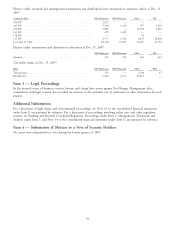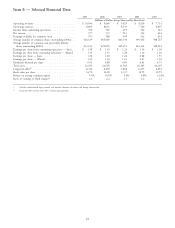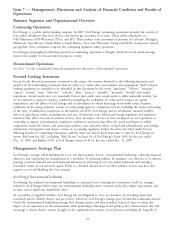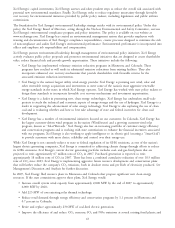Xcel Energy 2007 Annual Report Download - page 43
Download and view the complete annual report
Please find page 43 of the 2007 Xcel Energy annual report below. You can navigate through the pages in the report by either clicking on the pages listed below, or by using the keyword search tool below to find specific information within the annual report.We are subject to physical and financial risks associated with climate change.
There is a growing consensus that emissions of GHGs are linked to global climate change. Climate change creates
physical and financial risk. Physical risks from climate change include an increase in sea level and changes in weather
conditions, such as an increase in changes in precipitation and extreme weather events. Xcel Energy does not serve any
coastal communities so the possibility of sea level rises does not directly affect Xcel Energy or its customers. Our
customers’ energy needs vary with weather conditions, primarily temperature and humidity. For residential customers,
heating and cooling represent their largest energy use. To the extent weather conditions are affected by climate change,
customers’ energy use could increase or decrease depending on the duration and magnitude of the changes. Increased
energy use due to weather changes may require us to invest in more generating assets, transmission and other
infrastructure to serve increased load. Decreased energy use due to weather changes may affect our financial condition,
through decreased revenues. Extreme weather conditions in general require more system backup, adding to costs, and
can contribute to increased system stresses, including service interruptions. Weather conditions outside of the company’s
service territory could also have an impact on Xcel Energy revenues. Xcel Energy buys and sells electricity depending
upon system needs and market opportunities. Extreme weather conditions creating high energy demand on our own
and/or other systems may raise electricity prices as we buy short-term energy to serve our own system, which would
increase the cost of energy we provide to our customers. Severe weather impacts Xcel Energy service territories,
primarily through thunderstorms, tornadoes and snow or ice storms. We include storm restoration in our budgeting
process as a normal business expense and we anticipate continuing to do so. To the extent the frequency of extreme
weather events increases, this could increase our cost of providing service. Changes in precipitation resulting in droughts
or water shortages could adversely affect our operations, principally our fossil generating units. A negative impact to
water supplies due to long-term drought conditions could adversely impact our ability to provide electricity to
customers, as well as increase the price they pay for energy. We may not recover all costs related to mitigating these
physical and financial risks.
To the extent climate change impacts a region’s economic health, it may also impact Xcel Energy revenues. Xcel
Energy’s financial performance is tied to the health of the regional economies we serve. The price of energy, as a factor
in a region’s cost of living as well as an important input into the cost of goods, has an impact on the economic health
of our communities. The cost of additional regulatory requirements, such as a tax on GHGs or additional
environmental regulation, would normally be borne by consumers through higher prices for energy and purchased
goods. To the extent financial markets view climate change and emissions of GHGs as a financial risk, this could
negatively affect our ability to access capital markets or cause Xcel Energy to receive less than ideal terms and
conditions.
We may be subject to legislative and regulatory responses to climate change, with which compliance could be difficult
and costly.
Legislative and regulatory responses related to climate change create financial risk. Increased public awareness and
concern may result in more regional and/or federal requirements to reduce or mitigate the effects of GHG. Numerous
states have announced or adopted programs to stabilize and reduce GHG and federal legislation has been introduced in
both houses of Congress. Xcel Energy’s electric generating facilities are likely to be subject to regulation under climate
change policies introduced at either the state or federal level within the next few years. Xcel Energy is advocating with
state and federal policy makers to design climate change regulation that is effective, flexible, low-cost and consistent
with the our environmental leadership strategy.
Many of the federal and state climate change legislative proposals use a ‘‘cap and trade’’ policy structure, in which GHG
emissions from a broad cross-section of the economy would be subject to an overall cap. Under the proposals, the cap
becomes more stringent with the passage of time. The proposals establish mechanisms for GHG sources, such as power
plants, to obtain ‘‘allowances’’ or permits to emit GHGs during the course of a year. The sources may use the
allowances to cover their own emissions or sell them to other sources that do not hold enough emissions for their own
operations. Proponents of the cap and trade policy believe it will result in the most cost effective, flexible emission
reductions. The impact of legislation and regulations, including a ‘‘cap and trade’’ structure, on Xcel Energy and its
customers will depend on a number of factors, including whether GHG sources in multiple sectors of the economy are
regulated, the overall GHG emissions cap level, the degree to which GHG offsets are allowed, the allocation of
emission allowances to specific sources and the indirect impact of carbon regulation on natural gas and coal prices. An
important factor is Xcel Energy’s ability to recover the costs incurred to comply with any regulatory requirements that
are ultimately imposed. We may not recover all costs related to complying with regulatory requirements imposed on
Xcel Energy or its operating subsidiaries. If our regulators do not allow us to recover all or a part of the cost of capital
33


